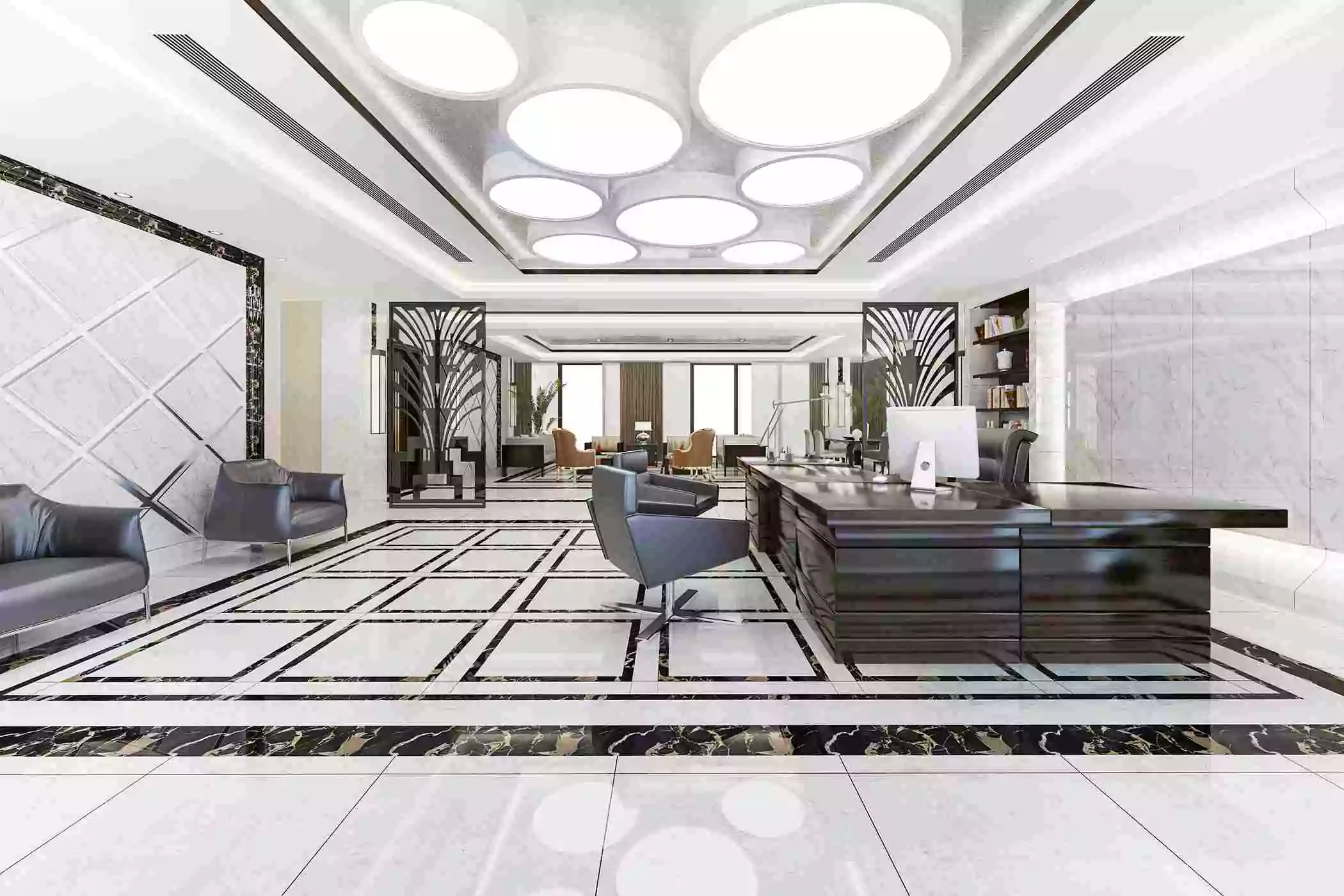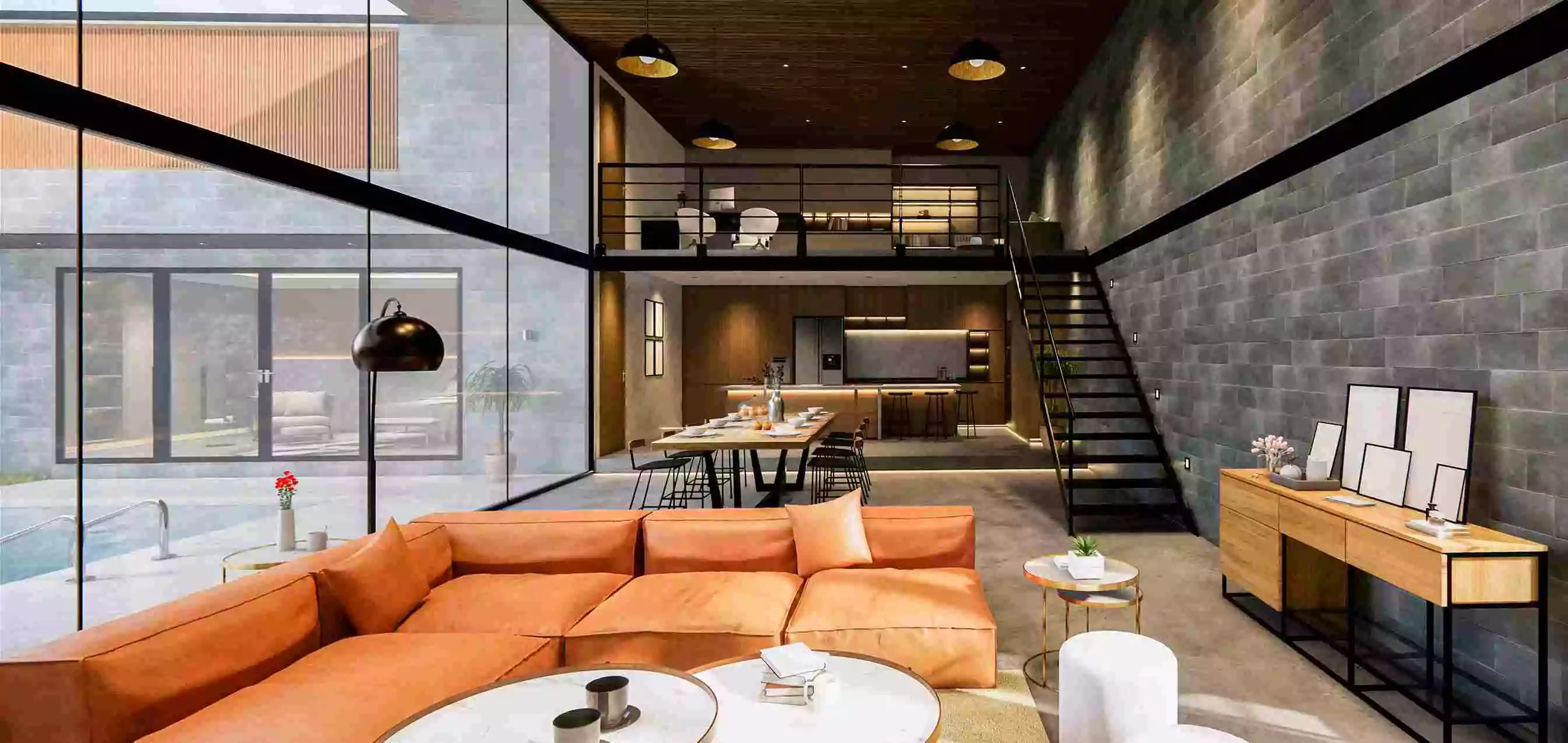How AI is Shaping the Future of Commercial Interior Design
How AI is Shaping the Future of Commercial Interior Design
5 septembre 2024
In the ever-evolving world of interior design, technology is playing an increasingly pivotal role in shaping how spaces are conceived, planned, and executed. Artificial Intelligence (AI) is at the forefront of this transformation, revolutionizing commercial interior design by offering innovative solutions that streamline processes and enhance creativity. At Styly, we are harnessing the power of AI to provide groundbreaking tools that cater to the diverse needs of designers, architects, and business owners. From AI room design to free interior design platforms, AI is redefining the landscape of commercial interior design.
1. AI-Driven Design: Transforming Spaces with Precision
AI-powered tools are enabling designers to generate precise, data-driven designs that cater to specific functional and aesthetic requirements. For instance, with AI interior design platforms, designers can input parameters such as space dimensions, purpose, and style preferences. The AI then processes this information to suggest optimal layouts, furniture arrangements, and even color schemes. This technology not only saves time but also minimizes errors, allowing for more efficient project execution. Styly’s AI-driven platform offers free interior design solutions, making advanced design accessible to all.
2. Personalization at Scale: Tailoring Designs to Individual Needs
One of the most significant advantages of AI in commercial interior design is its ability to deliver personalized designs at scale. Whether it's a retail store, office space, or a hospitality venue, AI can analyze user behavior, preferences, and industry trends to create customized design solutions. This level of personalization extends beyond aesthetics to include functional elements such as optimizing traffic flow, improving lighting conditions, and selecting appropriate materials. With Styly, users can explore a variety of interior design styles and find inspiration for home decor ideas that suit their unique tastes.
3. Enhancing Visualization with AI-Powered Tools
Visualization is a critical aspect of the design process, and AI is enhancing this experience with advanced tools such as 3D modeling and virtual reality. These tools allow clients to virtually walk through a space before it is built, clearly understanding the final outcome. AI can also generate realistic renderings that include intricate details like textures, lighting effects, and furniture placement. Platforms like Styly’s AI room design tool enable users to visualize their projects in real time, making it easier to make informed decisions and adjustments.
In the ever-evolving world of interior design, technology is playing an increasingly pivotal role in shaping how spaces are conceived, planned, and executed. Artificial Intelligence (AI) is at the forefront of this transformation, revolutionizing commercial interior design by offering innovative solutions that streamline processes and enhance creativity. At Styly, we are harnessing the power of AI to provide groundbreaking tools that cater to the diverse needs of designers, architects, and business owners. From AI room design to free interior design platforms, AI is redefining the landscape of commercial interior design.
1. AI-Driven Design: Transforming Spaces with Precision
AI-powered tools are enabling designers to generate precise, data-driven designs that cater to specific functional and aesthetic requirements. For instance, with AI interior design platforms, designers can input parameters such as space dimensions, purpose, and style preferences. The AI then processes this information to suggest optimal layouts, furniture arrangements, and even color schemes. This technology not only saves time but also minimizes errors, allowing for more efficient project execution. Styly’s AI-driven platform offers free interior design solutions, making advanced design accessible to all.
2. Personalization at Scale: Tailoring Designs to Individual Needs
One of the most significant advantages of AI in commercial interior design is its ability to deliver personalized designs at scale. Whether it's a retail store, office space, or a hospitality venue, AI can analyze user behavior, preferences, and industry trends to create customized design solutions. This level of personalization extends beyond aesthetics to include functional elements such as optimizing traffic flow, improving lighting conditions, and selecting appropriate materials. With Styly, users can explore a variety of interior design styles and find inspiration for home decor ideas that suit their unique tastes.
3. Enhancing Visualization with AI-Powered Tools
Visualization is a critical aspect of the design process, and AI is enhancing this experience with advanced tools such as 3D modeling and virtual reality. These tools allow clients to virtually walk through a space before it is built, clearly understanding the final outcome. AI can also generate realistic renderings that include intricate details like textures, lighting effects, and furniture placement. Platforms like Styly’s AI room design tool enable users to visualize their projects in real time, making it easier to make informed decisions and adjustments.
In the ever-evolving world of interior design, technology is playing an increasingly pivotal role in shaping how spaces are conceived, planned, and executed. Artificial Intelligence (AI) is at the forefront of this transformation, revolutionizing commercial interior design by offering innovative solutions that streamline processes and enhance creativity. At Styly, we are harnessing the power of AI to provide groundbreaking tools that cater to the diverse needs of designers, architects, and business owners. From AI room design to free interior design platforms, AI is redefining the landscape of commercial interior design.
1. AI-Driven Design: Transforming Spaces with Precision
AI-powered tools are enabling designers to generate precise, data-driven designs that cater to specific functional and aesthetic requirements. For instance, with AI interior design platforms, designers can input parameters such as space dimensions, purpose, and style preferences. The AI then processes this information to suggest optimal layouts, furniture arrangements, and even color schemes. This technology not only saves time but also minimizes errors, allowing for more efficient project execution. Styly’s AI-driven platform offers free interior design solutions, making advanced design accessible to all.
2. Personalization at Scale: Tailoring Designs to Individual Needs
One of the most significant advantages of AI in commercial interior design is its ability to deliver personalized designs at scale. Whether it's a retail store, office space, or a hospitality venue, AI can analyze user behavior, preferences, and industry trends to create customized design solutions. This level of personalization extends beyond aesthetics to include functional elements such as optimizing traffic flow, improving lighting conditions, and selecting appropriate materials. With Styly, users can explore a variety of interior design styles and find inspiration for home decor ideas that suit their unique tastes.
3. Enhancing Visualization with AI-Powered Tools
Visualization is a critical aspect of the design process, and AI is enhancing this experience with advanced tools such as 3D modeling and virtual reality. These tools allow clients to virtually walk through a space before it is built, clearly understanding the final outcome. AI can also generate realistic renderings that include intricate details like textures, lighting effects, and furniture placement. Platforms like Styly’s AI room design tool enable users to visualize their projects in real time, making it easier to make informed decisions and adjustments.
In the ever-evolving world of interior design, technology is playing an increasingly pivotal role in shaping how spaces are conceived, planned, and executed. Artificial Intelligence (AI) is at the forefront of this transformation, revolutionizing commercial interior design by offering innovative solutions that streamline processes and enhance creativity. At Styly, we are harnessing the power of AI to provide groundbreaking tools that cater to the diverse needs of designers, architects, and business owners. From AI room design to free interior design platforms, AI is redefining the landscape of commercial interior design.
1. AI-Driven Design: Transforming Spaces with Precision
AI-powered tools are enabling designers to generate precise, data-driven designs that cater to specific functional and aesthetic requirements. For instance, with AI interior design platforms, designers can input parameters such as space dimensions, purpose, and style preferences. The AI then processes this information to suggest optimal layouts, furniture arrangements, and even color schemes. This technology not only saves time but also minimizes errors, allowing for more efficient project execution. Styly’s AI-driven platform offers free interior design solutions, making advanced design accessible to all.
2. Personalization at Scale: Tailoring Designs to Individual Needs
One of the most significant advantages of AI in commercial interior design is its ability to deliver personalized designs at scale. Whether it's a retail store, office space, or a hospitality venue, AI can analyze user behavior, preferences, and industry trends to create customized design solutions. This level of personalization extends beyond aesthetics to include functional elements such as optimizing traffic flow, improving lighting conditions, and selecting appropriate materials. With Styly, users can explore a variety of interior design styles and find inspiration for home decor ideas that suit their unique tastes.
3. Enhancing Visualization with AI-Powered Tools
Visualization is a critical aspect of the design process, and AI is enhancing this experience with advanced tools such as 3D modeling and virtual reality. These tools allow clients to virtually walk through a space before it is built, clearly understanding the final outcome. AI can also generate realistic renderings that include intricate details like textures, lighting effects, and furniture placement. Platforms like Styly’s AI room design tool enable users to visualize their projects in real time, making it easier to make informed decisions and adjustments.
4. Streamlining Collaboration Between Designers and Clients
AI is also bridging the gap between designers and clients by facilitating smoother communication and collaboration. AI-powered design platforms enable real-time updates and feedback loops, ensuring that both parties are aligned throughout the project. Designers can share digital mockups and receive instant feedback, allowing for quick revisions and a more agile design process. This seamless collaboration is particularly beneficial for architectural firms and commercial projects where timelines and precision are crucial.
5. Sustainable Design Solutions Powered by AI
Sustainability is a growing concern in commercial interior design, and AI plays a vital role in promoting eco-friendly practices. AI tools can analyze energy consumption patterns, suggest sustainable materials, and optimize layouts for better natural light usage. By incorporating AI, designers can create spaces that are not only aesthetically pleasing but also environmentally responsible. Styly’s platform provides options for sustainable design choices, aligning with the global push towards greener practices.
6. Cost-Effective Design Solutions
AI is making high-quality interior design more accessible and cost-effective. With AI-driven platforms, users can explore free interior AI tools that provide professional-grade design assistance without the hefty price tag. This democratization of design allows small businesses and startups to access top-tier design solutions that were once reserved for larger, well-funded projects. Whether you’re looking for living room ideas or planning the interior design for a house, AI offers affordable solutions that cater to various budgets.
4. Streamlining Collaboration Between Designers and Clients
AI is also bridging the gap between designers and clients by facilitating smoother communication and collaboration. AI-powered design platforms enable real-time updates and feedback loops, ensuring that both parties are aligned throughout the project. Designers can share digital mockups and receive instant feedback, allowing for quick revisions and a more agile design process. This seamless collaboration is particularly beneficial for architectural firms and commercial projects where timelines and precision are crucial.
5. Sustainable Design Solutions Powered by AI
Sustainability is a growing concern in commercial interior design, and AI plays a vital role in promoting eco-friendly practices. AI tools can analyze energy consumption patterns, suggest sustainable materials, and optimize layouts for better natural light usage. By incorporating AI, designers can create spaces that are not only aesthetically pleasing but also environmentally responsible. Styly’s platform provides options for sustainable design choices, aligning with the global push towards greener practices.
6. Cost-Effective Design Solutions
AI is making high-quality interior design more accessible and cost-effective. With AI-driven platforms, users can explore free interior AI tools that provide professional-grade design assistance without the hefty price tag. This democratization of design allows small businesses and startups to access top-tier design solutions that were once reserved for larger, well-funded projects. Whether you’re looking for living room ideas or planning the interior design for a house, AI offers affordable solutions that cater to various budgets.
4. Streamlining Collaboration Between Designers and Clients
AI is also bridging the gap between designers and clients by facilitating smoother communication and collaboration. AI-powered design platforms enable real-time updates and feedback loops, ensuring that both parties are aligned throughout the project. Designers can share digital mockups and receive instant feedback, allowing for quick revisions and a more agile design process. This seamless collaboration is particularly beneficial for architectural firms and commercial projects where timelines and precision are crucial.
5. Sustainable Design Solutions Powered by AI
Sustainability is a growing concern in commercial interior design, and AI plays a vital role in promoting eco-friendly practices. AI tools can analyze energy consumption patterns, suggest sustainable materials, and optimize layouts for better natural light usage. By incorporating AI, designers can create spaces that are not only aesthetically pleasing but also environmentally responsible. Styly’s platform provides options for sustainable design choices, aligning with the global push towards greener practices.
6. Cost-Effective Design Solutions
AI is making high-quality interior design more accessible and cost-effective. With AI-driven platforms, users can explore free interior AI tools that provide professional-grade design assistance without the hefty price tag. This democratization of design allows small businesses and startups to access top-tier design solutions that were once reserved for larger, well-funded projects. Whether you’re looking for living room ideas or planning the interior design for a house, AI offers affordable solutions that cater to various budgets.




7. AI in Action: Real-World Applications
AI’s impact on commercial interior design is already evident in various sectors. For instance, retail stores use AI to design customer-centric layouts that enhance the shopping experience. In the corporate world, AI is helping to create office spaces that boost productivity and employee well-being. The hospitality industry is leveraging AI to design spaces that offer personalized experiences to guests. These real-world applications demonstrate the versatility and effectiveness of AI in commercial interior design.
Conclusion
As AI continues to evolve, its influence on commercial interior design will grow stronger. From streamlining design processes to offering personalized and sustainable solutions, AI is reshaping the future of how we approach commercial spaces. At Styly, we are committed to pushing the boundaries of design with our AI-powered tools, providing users with innovative solutions that make interior design more accessible, efficient, and inspiring. Whether you’re an architectural firm, a business owner, or a designer looking to explore new possibilities, AI is the key to unlocking the next generation of commercial interior design.
Explore Styly’s AI interior design tools today and discover how AI can transform your commercial spaces into stunning, functional, personalized environments.
7. AI in Action: Real-World Applications
AI’s impact on commercial interior design is already evident in various sectors. For instance, retail stores use AI to design customer-centric layouts that enhance the shopping experience. In the corporate world, AI is helping to create office spaces that boost productivity and employee well-being. The hospitality industry is leveraging AI to design spaces that offer personalized experiences to guests. These real-world applications demonstrate the versatility and effectiveness of AI in commercial interior design.
Conclusion
As AI continues to evolve, its influence on commercial interior design will grow stronger. From streamlining design processes to offering personalized and sustainable solutions, AI is reshaping the future of how we approach commercial spaces. At Styly, we are committed to pushing the boundaries of design with our AI-powered tools, providing users with innovative solutions that make interior design more accessible, efficient, and inspiring. Whether you’re an architectural firm, a business owner, or a designer looking to explore new possibilities, AI is the key to unlocking the next generation of commercial interior design.
Explore Styly’s AI interior design tools today and discover how AI can transform your commercial spaces into stunning, functional, personalized environments.



